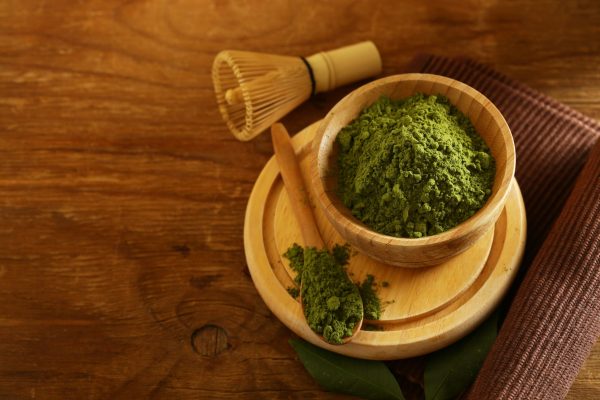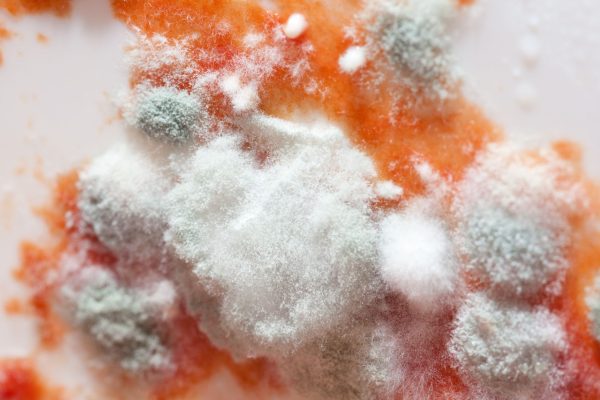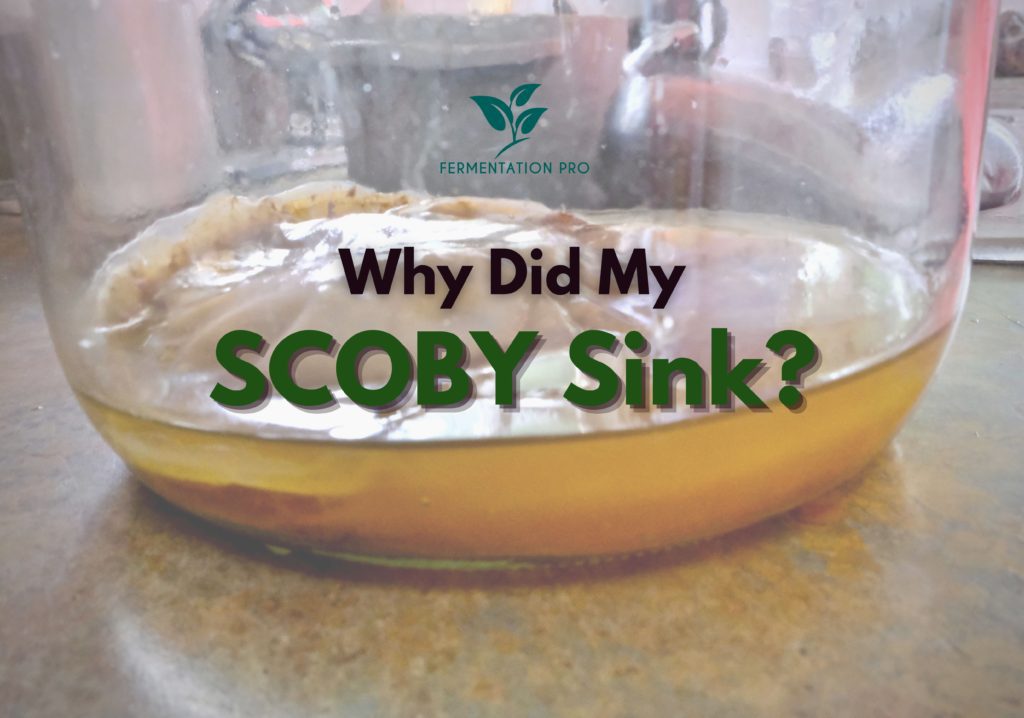A sunken SCOBY is probably one of the most daunting phenomena in brewing Kombucha. But fear not, because a sunken SCOBY is not a sign of SCOBY death or bad health. The SCOBY sinks simply because of the weight of the tea, temperature change, and SCOBY’s age and density.
The position of the SCOBY doesn’t really matter and is never used as an indicator of SCOBY’s health or the brew’s quality. SCOBYs can sink, float, or settle in the middle of the jar during brewing. So if your SCOBY sinks, you don’t need to do anything but rather let your Kombucha brew on its own.
Read on as we discuss more about SCOBY and the reasons why SCOBY sinks.
Furthermore, we will discuss other related topics like signs of a dying SCOBY and how often you should feed SCOBYs in a SCOBY hotel. Let’s jump into it.
Table of Contents
Why Did My SCOBY Sink?
SCOBY stands for Symbiotic Colony of Bacteria and Yeast. The SCOBY is necessary for brewing Kombucha because it converts the sweet tea to the Kombucha we all love. In addition to making Kombucha, the SCOBY also keeps the drink acidic to prevent the growth of harmful microorganisms that can damage the brew. These functions are not affected or influenced by the position of the SCOBY in the brewing jar.
The position of the SCOBY inside your Kombucha brew is not related to the SCOBY’s health or its ability for brewing. A sunken SCOBY is mainly because of three reasons which are the tea weight, temperature change and the SCOBY’s age and density. Below we explain these reasons one by one.
Tea Weight
When you drop a SCOBY in a new batch of Kombucha, the SCOBY is very likely to sink because of the weight of the tea aboved the SCOBY. As the fermentation continues, you can see that the SCOBY will gradually rise to the surface of the Kombucha. This happens because of the Carbon Dioxide (CO2) produced by the yeasts in the SCOBY during the fermentation process. The CO2 pushes the SCOBY up to the brew’s surface.

SCOBY rising to the surface due to CO2 is completely okay and in no way relevant to the Kombucha quality and SCOBY’s health. In fact, the production of CO2 is a positive sign that the bacteria and yeast are well fed and are working properly. With a good CO2 production, the SCOBY is likely to stay on the surface during the fermentation process.
Temperature Change
Some SCOBYs will float when you add them to the new batch of Kombucha and sink in the middle of fermentation. If this happens to your SCOBY, do not panic because this is mostly because of the temperature. Kombucha ferments best at temperatures between 75℉ to 85℉. In this temperature, the yeasts become very active and speed up the fermentation process.
However, if the temperature drops, the yeast can become less active and the CO2 produced also becomes lesser. When the CO2 is less, there is less force to keep your SCOBY on the surface. Additionally, the fermentation can take longer due to the less active yeast at work.
It’s totally fine if the fermentation will take longer however if you want to brew your Kombucha faster, we recommend moving your Kombucha in a hotter place that is between 75℉ to 85℉.
SCOBY’s Age and Density
Young SCOBYs may not be active enough for fermentation and good production of CO2. In this case, the SCOBY will continue to stay at the bottom during the fermentation process. Moreover, the fermentation process can also take longer. Young SCOBYs typically need a longer time of fermentation and several batches of brew before they can produce enough CO2 to push the SCOBY up the surface and keep the SCOBY from sinking.
In addition to the SCOBY’s age, the SCOBY density is another factor for a sunken SCOBY. SCOBYs come in different sizes and density. A denser SCOBY is more likely to sink while a thin SCOBY often floats when added to a new batch of Kombucha.
Is It Normal For SCOBY to Sink?
Yes. It is completely normal for a SCOBY to sink as well as float or settle in the middle of the fermentation jar. A sunken SCOBY is not a sign of unhealthy SCOBY or bad brew. It is simply just because of the tea weight, temperature change, and SCOBY’s age and density.
After a few days, a baby SCOBY can form on the surface of your brew. Ideally, the baby SCOBY should stay across the top of the jar. Baby SCOBYs often form after 7 days of fermentation.
How Do You Know If Your SCOBY is dying?
It is relatively easy to spot a dying SCOBY because of the distinct symptoms that you can easily see on the SCOBY or your brew. These symptoms include:
- Bad smell
A healthy SCOBY should give your brew a sweet-sour smell. Sometimes, it can take a few days before the sweet tea acquires this smell so just wait a little. However, if the smell becomes off and your brew starts smelling like a rotting matter during fermentation, then your SCOBY is very likely to be unhealthy. A bad smell is a strong indicator that the SCOBY has been contaminated by bad bacteria and should be discarded together with the Kombucha brewed with it.
- Molds
Molds are fungi that appear as fuzzy spots and are often white or colored. Molds like to stay near air, so you will easily spot them on top of your brew or on the surface of your floating SCOBY. If your brew or SCOBY has molds, do not think twice and immediately dispose of them. Depending on the amount of molds digested, one can experience side effects like vomiting, diarrhea, liver disease, and even death.

If molds easily grow in your home, you should make sure to store your Kombucha away from any areas that can cause contamination like the trash bin or a leak in the house.
Additionally, you should only use clean utensils in stirring your Kombucha and keep the temperature at a constant level between 75℉ to 85℉. For a complete guide on cleaning and preventing molds in your home, feel free to check this brief guide from the Environmental Protection Agency.
- No visible growth
A healthy SCOBY should be able to grow and cover the surface of your fermentation jar. It should also develop SCOBY babies during the fermentation process. If your SCOBY doesn’t show any growth after several days of fermentation, there might be something wrong with your SCOBY. However, this could only be caused by the temperature. If your SCOBY is taking long to grow, you might just need to adjust the temperature to about 80℉ to 85℉ to speed up the fermentation and encourage the yeast to be active.
Another reason why a SCOBY doesn’t grow is that it could have been damaged when it was added to the new batch of Kombucha. If the SCOBY has been added to a new batch of Kombucha while the tea is still too hot, the SCOBY can get damaged or even die. In this case, you will need to start a new brew with a different SCOBY.
- Change in color
It is normal for the SCOBY to change from dark to light color during fermentation. This simply happens because the tannins, which gives the tea its color, is being converted by the SCOBY.
However, if your SCOBY turns black, then it is very likely to have already died.
Dead SCOBYs shouldn’t be used in fermenting Kombucha and should be thrown out as soon as possible together with the Kombucha brewed with it.
- High pH level
Kombucha should be acidic enough to prevent the growth of harmful microorganisms that can contaminate the brew. The SCOBY keeps the Kombucha acidic. When the yeasts transform sugar into ethanol, the bacteria feed on the ethanol and turn it into acidity.
With a healthy SCOBY, the Kombucha should have a pH level of 2 to 4 pH. If the Kombucha becomes less acidic and more alkaline with a pH level that ranges from 7 to 14 pH, then the SCOBY is very likely to have stopped working and has already been spoiled.

How Often Do I Feed My SCOBY Hotel?
A SCOBY hotel is generally low maintenance. However, you should remember to keep your SCOBYs well fed to keep the colony of bacteria and yeast healthy. The ideal time to feed your SCOBY hotel is every 4 to 6 weeks with Kombucha or sweet tea.
Can I Put a Lid on My SCOBY Hotel?
Yes, you certainly can put a lid on your SCOBY hotel. However, you should avoid using metal lids. If you must use a metal lid, opt for a stainless steel lid. Kombucha is naturally acidic and can pull toxic elements from metal into your brew. However, using metal spoons, strainers, or scissors are okay as long as it is just for a short time.
Instead of metal, it’s better to use plastic lids. You can also use a cloth to cover your SCOBY hotel jar however the hotel liquid can evaporate more quickly with this type of lid. When the liquid evaporates faster, you will need to check on your Kombucha hotel more often and add more Kombucha or sweet tea to replenish the evaporated liquid. When a new SCOBY forms on the surface of the Kombucha liquid, the evaporation will be slowed down and you can check on your hotel less often.








